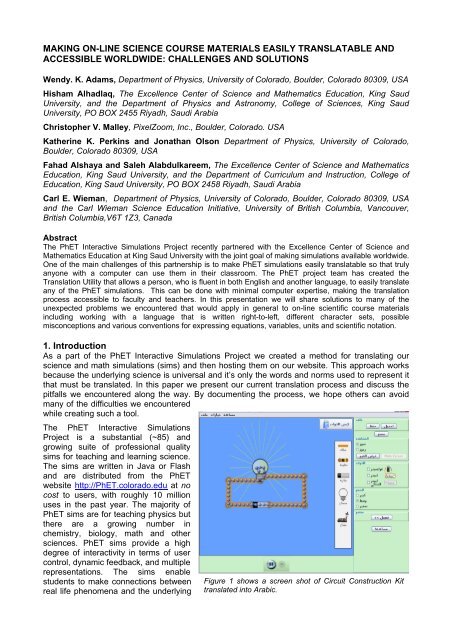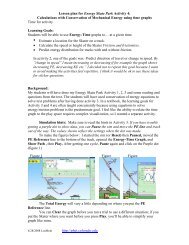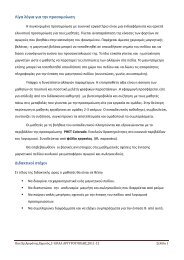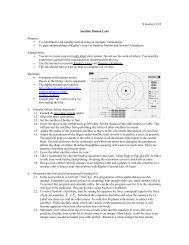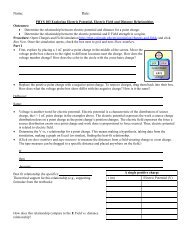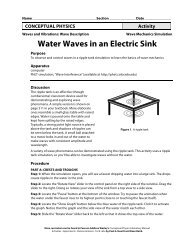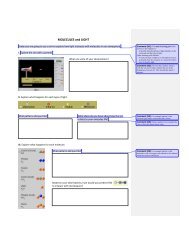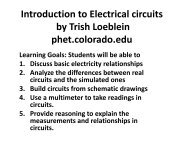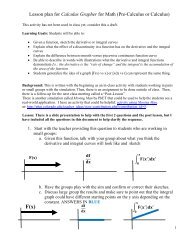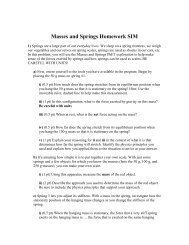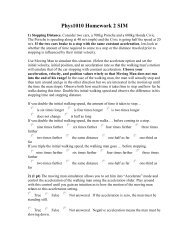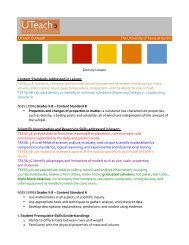making on-line science course materials easily translatable - PhET
making on-line science course materials easily translatable - PhET
making on-line science course materials easily translatable - PhET
You also want an ePaper? Increase the reach of your titles
YUMPU automatically turns print PDFs into web optimized ePapers that Google loves.
MAKING ON-LINE SCIENCE COURSE MATERIALS EASILY TRANSLATABLE ANDACCESSIBLE WORLDWIDE: CHALLENGES AND SOLUTIONSWendy. K. Adams, Department of Physics, University of Colorado, Boulder, Colorado 80309, USAHisham Alhadlaq, The Excellence Center of Science and Mathematics Educati<strong>on</strong>, King SaudUniversity, and the Department of Physics and Astr<strong>on</strong>omy, College of Sciences, King SaudUniversity, PO BOX 2455 Riyadh, Saudi ArabiaChristopher V. Malley, PixelZoom, Inc., Boulder, Colorado. USAKatherine K. Perkins and J<strong>on</strong>athan Ols<strong>on</strong> Department of Physics, University of Colorado,Boulder, Colorado 80309, USAFahad Alshaya and Saleh Alabdulkareem, The Excellence Center of Science and MathematicsEducati<strong>on</strong>, King Saud University, and the Department of Curriculum and Instructi<strong>on</strong>, College ofEducati<strong>on</strong>, King Saud University, PO BOX 2458 Riyadh, Saudi ArabiaCarl E. Wieman, Department of Physics, University of Colorado, Boulder, Colorado 80309, USAand the Carl Wieman Science Educati<strong>on</strong> Initiative, University of British Columbia, Vancouver,British Columbia,V6T 1Z3, CanadaAbstractThe <strong>PhET</strong> Interactive Simulati<strong>on</strong>s Project recently partnered with the Excellence Center of Science andMathematics Educati<strong>on</strong> at King Saud University with the joint goal of <str<strong>on</strong>g>making</str<strong>on</strong>g> simulati<strong>on</strong>s available worldwide.One of the main challenges of this partnership is to make <strong>PhET</strong> simulati<strong>on</strong>s <strong>easily</strong> <strong>translatable</strong> so that trulyany<strong>on</strong>e with a computer can use them in their classroom. The <strong>PhET</strong> project team has created theTranslati<strong>on</strong> Utility that allows a pers<strong>on</strong>, who is fluent in both English and another language, to <strong>easily</strong> translateany of the <strong>PhET</strong> simulati<strong>on</strong>s. This can be d<strong>on</strong>e with minimal computer expertise, <str<strong>on</strong>g>making</str<strong>on</strong>g> the translati<strong>on</strong>process accessible to faculty and teachers. In this presentati<strong>on</strong> we will share soluti<strong>on</strong>s to many of theunexpected problems we encountered that would apply in general to <strong>on</strong>-<strong>line</strong> scientific <strong>course</strong> <strong>materials</strong>including working with a language that is written right-to-left, different character sets, possiblemisc<strong>on</strong>cepti<strong>on</strong>s and various c<strong>on</strong>venti<strong>on</strong>s for expressing equati<strong>on</strong>s, variables, units and scientific notati<strong>on</strong>.1. Introducti<strong>on</strong>As a part of the <strong>PhET</strong> Interactive Simulati<strong>on</strong>s Project we created a method for translating our<strong>science</strong> and math simulati<strong>on</strong>s (sims) and then hosting them <strong>on</strong> our website. This approach worksbecause the underlying <strong>science</strong> is universal and it’s <strong>on</strong>ly the words and norms used to represent itthat must be translated. In this paper we present our current translati<strong>on</strong> process and discuss thepitfalls we encountered al<strong>on</strong>g the way. By documenting the process, we hope others can avoidmany of the difficulties we encounteredwhile creating such a tool.The <strong>PhET</strong> Interactive Simulati<strong>on</strong>sProject is a substantial (~85) andgrowing suite of professi<strong>on</strong>al qualitysims for teaching and learning <strong>science</strong>.The sims are written in Java or Flashand are distributed from the <strong>PhET</strong>website http://<strong>PhET</strong>.colorado.edu at nocost to users, with roughly 10 milli<strong>on</strong>uses in the past year. The majority of<strong>PhET</strong> sims are for teaching physics butthere are a growing number inchemistry, biology, math and other<strong>science</strong>s. <strong>PhET</strong> sims provide a highdegree of interactivity in terms of userc<strong>on</strong>trol, dynamic feedback, and multiplerepresentati<strong>on</strong>s. The sims enablestudents to make c<strong>on</strong>necti<strong>on</strong>s betweenreal life phenomena and the underlyingFigure 1 shows a screen shot of Circuit C<strong>on</strong>structi<strong>on</strong> Kittranslated into Arabic.
<strong>science</strong> which explains such phenomena (Fig. 1). Our team of scientists, software engineers and<strong>science</strong> educators use a research based approach – incorporating findings from prior research andour own testing – to create sims that support student engagement with and understanding ofscientific c<strong>on</strong>cepts. Our research includes investigating the use of <strong>PhET</strong> sims in a variety ofeducati<strong>on</strong>al settings. (<strong>PhET</strong>, 2009).In this paper we will describe our current soluti<strong>on</strong> for translating the sims and our website includinga few brief examples of the technical c<strong>on</strong>cerns involved. We also explain the method we settled <strong>on</strong>for finding translators and our co-authors from the Excellence Center of Science and MathematicsEducati<strong>on</strong> (ECSME) at King Saud University will share their experience as users of our Translati<strong>on</strong>Utility. Creating this method for translating sims was a difficult and time c<strong>on</strong>suming process;however it was much more efficient than rewriting the sims from scratch. It also allows a singlelocati<strong>on</strong> to host the same product in multiple languages, giving the instructor the opportunity tochoose which language s/he will use in their classroom.2. Current Soluti<strong>on</strong>Developing software for world-wide use involves addressing two related issues: internati<strong>on</strong>alizati<strong>on</strong>and localizati<strong>on</strong>. Internati<strong>on</strong>alizati<strong>on</strong> is the process of designing software so that it can be adaptedto various locales without engineering changes (Deitsch, 2001). Internati<strong>on</strong>alizati<strong>on</strong> is oftenabbreviated as i18n (there are 18 characters between 'i' and 'n'). Localizati<strong>on</strong> is the process ofadapting internati<strong>on</strong>alized software for a specific locale (language and country) (Deitsch, 2001).This paper will address <strong>on</strong>e aspect of localizati<strong>on</strong>: translati<strong>on</strong>. For technical details <strong>on</strong> how <strong>PhET</strong>has addressed other aspects of i18n and localizati<strong>on</strong>, see (Malley, 2009).In December of 2007 we released the initial versi<strong>on</strong> of the Translati<strong>on</strong> Utility (<strong>PhET</strong> Team, 2007)for our sims. The Translati<strong>on</strong> Utility is a program that allows the translator to see the Englishstrings as they enter their translati<strong>on</strong>. The translator can then test their work in the actual sim tomake sure it appears as intended. Once complete, the translator emails <strong>PhET</strong> the translatedstrings, we compile a translated versi<strong>on</strong> of the sim and make it available <strong>on</strong> the <strong>PhET</strong> website. Thissoluti<strong>on</strong> came after several other avenues for acquiring translati<strong>on</strong>s proved unsuccessful. Inadditi<strong>on</strong>, it has recently become obvious that we also need to have the delivery mechanism, thewebsite, in the user’s preferred language.2.1 TranslatorsThe most successful method for translating sims turned out to be a c<strong>on</strong>tributor model similar to theWikipedia editing model 1 . Instructors who use <strong>PhET</strong> sims volunteer their time and expertise tocreate translated sims. These instructors are ideally suited for creating the translated versi<strong>on</strong>s. Onthe surface this c<strong>on</strong>tributor model appears to be the least expensive; but, there are much morefundamental reas<strong>on</strong>s. Bi-lingual teachers who use the sims have three necessary characteristics:They know the scientific terms and notati<strong>on</strong> in both their language and English; They are using thesim in class so are familiar with the c<strong>on</strong>tent, and; they have a pers<strong>on</strong>al interest in the final productbecause they need to use it in their <strong>course</strong>(s). We have had <strong>on</strong>e other group that meets theserequirements who were not actual instructors. A teacher in Romania created a class project wherehis students each translated a sim and entered it in a c<strong>on</strong>test. These turned out to be of very highquality since the students were in the unusual situati<strong>on</strong> of knowing the sims, knowing the <strong>science</strong>of both languages and having motivati<strong>on</strong> to see the finished product. At the time of writing thispaper the Translati<strong>on</strong> Utility had been available for 20 m<strong>on</strong>ths and we had 1054 translati<strong>on</strong>s ofsims.It is useful to review our failed models. We first tried to use Google Translate to translate thewebsite and sims into Spanish which often resulted in incomprehensible, or highly inappropriate,Spanish phrasings. Next we tried hiring bilingual students, but it turned out to be very difficult tofind students with the necessary <strong>science</strong> background. Neither of these approaches led to a highqualityproduct and neither had the potential to lead to translati<strong>on</strong>s in 40 languages.One of the challenges for the translator includes keeping the string length to a minimum. <strong>PhET</strong>sims use very minimal text which means there is less to translate but it can be a challenge toexpress the idea in minimal wording. In additi<strong>on</strong>, sometimes there is not a direct translati<strong>on</strong> so it is1 Wikipedia’s editing model is not to be c<strong>on</strong>fused with their translati<strong>on</strong> model which has fully independent entries.
necessary that the translator completelyunderstand the material and c<strong>on</strong>text of itsuse, which is <strong>on</strong>e reas<strong>on</strong> the translatorusually has to be a teacher.2.2 Simulati<strong>on</strong> Translati<strong>on</strong> UtilityFigure 2 Shows the two windows ofthe Translati<strong>on</strong> Utility. A. The upperright depicts the initial window wherethe translator chooses their locale. B.The lower right window shows theworking window where the translatorenters their translated text into thetext boxes <strong>on</strong> the right side of thescreen.It may appear that the c<strong>on</strong>tributor model is a cost efficient opti<strong>on</strong>; however, professi<strong>on</strong>al softwaredevelopers are quite expensive, it took them 180 hours to create the translati<strong>on</strong> utility. Much of thistime was figuring out the most efficient design. Here we will describe much of what we learnedthrough this process in an attempt to save another group time during the development stage. Inadditi<strong>on</strong> to the actual utility, each sim has to be “internati<strong>on</strong>alized” by creating string variables(Malley, 2009).Translati<strong>on</strong> of both Java and Flash sims is supported by the Translati<strong>on</strong> Utility (<strong>PhET</strong> Team, 2007).The Utility provides a translator (a pers<strong>on</strong> creating a locale-specific translati<strong>on</strong>) with a GUI(Graphical User Interface) for creating <strong>PhET</strong> string files. Translators choose their locale from a listof locales (Fig. 2A). The GUI then displays two columns: a left column shows the English strings,and a right column allows translators to enter the corresp<strong>on</strong>ding strings for their locale (Fig. 2B). Atranslati<strong>on</strong> can be tested at any time by pressing a “Test” butt<strong>on</strong>, which will run the sim in thespecified locale, with the translator's strings. The translator should be checking that theirtranslati<strong>on</strong> is appropriate, is rendered properly, and does not create user-interface layout problems.Layout problems, can occur when a translated string is significantly l<strong>on</strong>ger or shorter than theoriginal English string. When the translati<strong>on</strong> is completed, pressing a “Submit” butt<strong>on</strong> creates astring file, which can then be emailed to <strong>PhET</strong>.Early attempts to specify locale used <strong>on</strong>ly a language code. Feedback from translators quickly toldus that language code al<strong>on</strong>e is inadequate; regi<strong>on</strong>al differences often require different translati<strong>on</strong>sfor the same language. For example, Chinese (language=zh) requires different translati<strong>on</strong> forChina (country=CN) and Taiwan (country=TW). So we need to be able to specify zh_CN andzh_TW as separate locales.Submissi<strong>on</strong>s are reviewed by <strong>PhET</strong>, and then published to the <strong>PhET</strong> website. When we “review” asubmitted translati<strong>on</strong> we are checking to see that it runs, is complete and the layout is O.K. But,we are not qualified to check the accuracy of translati<strong>on</strong>s. We depend <strong>on</strong> our user populati<strong>on</strong> t<strong>on</strong>otify us of problems – similar to Wikipedia’s editing model. So far we have received <strong>on</strong>ly a fewreplacement translati<strong>on</strong>s (typically more complete), but no objecti<strong>on</strong>s to any sim translati<strong>on</strong>s.2.3 WebsiteThe <strong>PhET</strong> website offers three possible delivery methods for simulati<strong>on</strong>s: 1) Run a sim <strong>on</strong><strong>line</strong>which involves clicking the “run now” butt<strong>on</strong> <strong>on</strong> the website – requires live Internet c<strong>on</strong>necti<strong>on</strong>; 2)Download an individual sim by choosing the “download” opti<strong>on</strong>, then the sim is saved to the user’scomputer for use at anytime; and 3) Download the <strong>PhET</strong> off<strong>line</strong> website. This is an installati<strong>on</strong>program that puts the website and all of its c<strong>on</strong>tent (except teacher c<strong>on</strong>tributed activities) <strong>on</strong>to theuser’s computer. A user then has access to all the sims and supporting material without the needfor an Internet c<strong>on</strong>necti<strong>on</strong>.All languages for each sim are available <strong>on</strong> the website. Access can be found either <strong>on</strong> eachindividual sim page or <strong>on</strong> the “translated sims” page. To deliver translated versi<strong>on</strong>s of the sims<strong>on</strong><strong>line</strong>, Java sims are run via locale-specific JNLP files, executed by Java Web Start, withtranslated strings bundled in the JAR file. Flash sims are run via locale-specific HTML files, with
translated strings embedded in the HTML. Flash passes the local to the Flash Player through whatis known as FlashVars.When users download an individual sim, they can choose which language they would like. This isd<strong>on</strong>e using local specific JAR files for both Flash and Java sims. The downloadable Flash sims arenow wrapped within a JAR file which has the disadvantage of requiring the user’s computer tohave Java in additi<strong>on</strong> to Flash. We have not received any complaints about this from users so itappears to be an adequate soluti<strong>on</strong>. For more detail please see the <strong>PhET</strong> Translati<strong>on</strong> TechnicalC<strong>on</strong>cerns document (Malley, 2009). Similarly the <strong>PhET</strong> off<strong>line</strong> website includes all the translatedversi<strong>on</strong>s of the sims which are available as JAR files.Our current website is written in JavaScript without i18n support. Until recently we decided that thesite would remain in English and users would hopefully be satisfied with just translated sims.However, our collaborators at ECSME have need for a fully translated mirror site. In additi<strong>on</strong> wehave found several independent groups who have translated the text in our web pages and postedthis translated versi<strong>on</strong> of the site to their own server. We are very happy to see this level ofinterest; however, it means that these sites are static and cannot reflect updates to the sims orother <strong>materials</strong> <strong>on</strong> the site. So we needed to find a way to make the website also <strong>easily</strong> translated.A cost-benefit analysis dem<strong>on</strong>strated that maintaining and adding necessary upgrades to thecurrent JavaScript site are nearly equal the cost of creating a new Java based using Wicketframework. So we’ve decided to do our 3 rd complete rewrite of the website. This new versi<strong>on</strong> willhave many new features including a very easy to use translati<strong>on</strong> interface, and it will allow the userto choose their preferred language from the homepage when browsing for sims. One of thechallenges is to make sure that when choosing languages, users can view the website withcomm<strong>on</strong> web browsers in different platforms without any encoding problems. This site should beavailable to the public in the spring of 2010.3. Arabic Translati<strong>on</strong> ExperiencesHere we discuss the work involved in translati<strong>on</strong> of <strong>PhET</strong> sims from English into the Arabiclanguage. Our experience again c<strong>on</strong>firms that an expert in scientific <strong>materials</strong> with bilingualknowledge is needed in order to have accurate and understandable scientific sims. We facedseveral challenges in translating <strong>PhET</strong> sims from English into Arabic that are shown to be comm<strong>on</strong>to other languages and could apply to any <strong>on</strong><strong>line</strong> scientific <strong>materials</strong>.First, <strong>on</strong>e of the biggest challenges is to make sure that words used in expressing scientificquantities and expressi<strong>on</strong>s are comm<strong>on</strong>ly used and understood in scientific <strong>materials</strong> that arebeing taught in schools and colleges across the Arabic-speaking countries. However, this hasproven to be difficult to do as what is widely used in <strong>on</strong>e country to express scientific quantitiesmight not be used in another country due to different scientific background and educati<strong>on</strong>alsystems. For example, "accelerati<strong>on</strong>" can be translated in two different ways, which some studentsare familiar with <strong>on</strong>e, but not the other. To complicate things further, even in the same country,educati<strong>on</strong>al systems vary between high school and college level. For example, in Saudi Arabia,math equati<strong>on</strong>s and scientific notati<strong>on</strong> are expressed using the Arabic language at the high schoollevel but in the English language at the college level. To overcome this problem, a specific versi<strong>on</strong>for each country is created and labeled using a locale that includes the language and country codewhile a more universal versi<strong>on</strong> for use in college is labeled with just the language code.Moreover, different c<strong>on</strong>venti<strong>on</strong>s for expressing units in Arabic exist, and for that reas<strong>on</strong>,abbreviati<strong>on</strong>s were mostly avoided in the general versi<strong>on</strong>s of the sims, unless it is explained, tomake sure variables and units can be understood. One drawback to this soluti<strong>on</strong> is that whenabbreviati<strong>on</strong>s are avoided, strings might be too l<strong>on</strong>g to fit in the allowed space in the sims. Again, apossible soluti<strong>on</strong> is to create different versi<strong>on</strong>s for each locale that uses the specific abbreviati<strong>on</strong>sand units used in teaching <strong>science</strong> in classes.Since the Arabic language is written from right-to-left, the directi<strong>on</strong> of equati<strong>on</strong>s and scientificnotati<strong>on</strong> also have to be written right-to-left. Handling this was a challenge when using theTranslati<strong>on</strong> Utility as it involves shifting between English and Arabic to embed Arabic text in htmlcodes and between brackets. The mixing of two languages with mixed directi<strong>on</strong>s in the same stringmakes it difficult to follow; however, the ability of testing sims using the Translati<strong>on</strong> Utility savestime and possible layout problems can be avoided. The reverse directi<strong>on</strong> complicates writing
equati<strong>on</strong>s from right-to-left in multiple strings as that might reverse order. A single string ispreferable for writing equati<strong>on</strong>s, however a string that is too l<strong>on</strong>g causes other problems.Chemical symbols (i.e. Na for Sodium) were kept in Roman letters as it is the standard in the Arabworld. Greek symbols used in <strong>science</strong> and math, the most obvious being “π”, are used in somecases and other abbreviati<strong>on</strong>s for symbols that are comm<strong>on</strong>ly used in Arabic textbooks were usedin others.For number formats, Arabic-speaking countries use two different systems: Arabic numerals (0, 1,2, 3, …), used in the West, and so-called Hindi numerals or Eastern Arabic numerals (٠ , ١, ٢, ٣,…). Some Arab countries use <strong>on</strong>ly Arabic numerals while others typically use the two systemsinterchangeably. We decided to use Arabic numerals rather than translating to Hindi since nearlyall students understand the Arabic numerals and additi<strong>on</strong>ally with Hindi it’s easy to c<strong>on</strong>fuse thezero (٠) and a decimal point (.). While text in Arabic runs from right-to-left, c<strong>on</strong>versely numeralsrun from left-to-right.One has to be careful when translating scientific <strong>materials</strong> to avoid possible misc<strong>on</strong>cepti<strong>on</strong>s thatmight arise from choosing a word that is correct linguistically, but might not reflect appropriatedescripti<strong>on</strong> of the intended scientific meaning. Words like “distance” and “displacement” used inmechanics should be carefully translated to reflect their scalar and vector meaning and to avoidusing them interchangeably. This again shows why it is best to have a teacher do the translati<strong>on</strong>s.4. Internati<strong>on</strong>alizati<strong>on</strong> of Scientific MaterialMany of the challenges that our colleagues from Saudi Arabia face, are comm<strong>on</strong> to otherlanguages as well. Languages that are written right-to-left clearly pose complicati<strong>on</strong>s whentranslating from a language such as English that is written left-to-right. Different character setsbring with them all sorts of f<strong>on</strong>t problems. If a user’s computer does not support the specified f<strong>on</strong>t,empty rectangles will be displayed for all characters. We incorrectly assumed when we started,that c<strong>on</strong>venti<strong>on</strong>s for expressing equati<strong>on</strong>s, variables, and mathematical symbols were universal.However, we were pleasantly shocked when we learned that chemical symbols, such as Na forsodium, are universal. So far we have not encountered an educator who does not use the IUPAC(Internati<strong>on</strong>al Uni<strong>on</strong> of Pure and Applied Chemistry) system for name and symbol of chemicalelements.5. C<strong>on</strong>clusi<strong>on</strong>We have created a Translati<strong>on</strong> Utility for translating <strong>PhET</strong> Interactive Simulati<strong>on</strong>s from English toany other language and a system for delivering these translated sims. We now have a process thatworks quite well and al<strong>on</strong>g the way we discovered many of our initial ideas were flawed. Currentlyscientists/teachers have c<strong>on</strong>tributed a total of 1054 translati<strong>on</strong>s in 40 different languages that wehost <strong>on</strong> our website. We learned after several other avenues failed, that translators must beteachers who use the sims in order to achieve precise translati<strong>on</strong> of scientific terminology. Al<strong>on</strong>gthe way we also discovered a few unexpected things about c<strong>on</strong>venti<strong>on</strong>s for expressing chemicalsymbols, scientific-notati<strong>on</strong>, mathematical symbols, abbreviati<strong>on</strong>s and numerals used in scientific<strong>materials</strong> across the globe.AcknowledgementsThis work would not have been possible without the expert simulati<strong>on</strong>s created by The <strong>PhET</strong>Team, particularly its superb software developers Sam Reid, Chris Malley, John Blanco, MikeDubs<strong>on</strong>, and J<strong>on</strong>athan Ols<strong>on</strong>. <strong>PhET</strong> is supported by the Nati<strong>on</strong>al Science Foundati<strong>on</strong>, the Williamand Flora Hewlett Foundati<strong>on</strong>, The Excellence Center of Science and Mathematics Educati<strong>on</strong>(ECSME) at King Saud University, JILA and the University of Colorado. ECSME is grateful for theMinistry of Higher Educati<strong>on</strong> and King Saud University, Riyadh, Saudi Arabia for their support.References<strong>PhET</strong> Interactive Simulati<strong>on</strong>s (2009). Research page: http://<strong>PhET</strong>.colorado.edu/research/index.php<strong>PhET</strong> Team (2007). The <strong>PhET</strong> Translati<strong>on</strong> Utility. http://phet.colorado.edu/c<strong>on</strong>tribute/translati<strong>on</strong>-utility.php).Deitsch, A. and Czarnecki, D. (2001). Java Internati<strong>on</strong>alizati<strong>on</strong>. M. Loukides Ed. Sebastopol, CA: O’Reilly &Associates, Inc.Malley, C. M. and Ols<strong>on</strong>, J. (2009). <strong>PhET</strong> Translati<strong>on</strong> Technical C<strong>on</strong>cerns. http://phet.colorado.edu/phetdist/publicati<strong>on</strong>s/Technical_c<strong>on</strong>cerns.pdf


